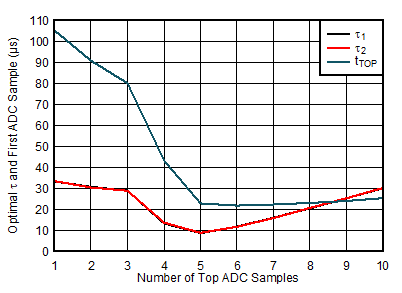SLVAEX3 October 2020 TPS8802 , TPS8804
3.3.5 Multiple ADC Sample Simulation
A simulation of the smoke measurement system is implemented in MATLAB. A nonlinear programming solver, fminsearch, optimizes the ADC timing, amplifier time constants, and unconstrained filter weights. The result of the optimization for a 100 μs LED pulse and 20 μs ADC sampling rate is shown in Figure 3-5. The average and matched filter have initial parameters of τ1 and τ2 set to 0.31 times tLED and the ADC samples centered on tLED. Unconstrained filtering improves the SNR the most, by 6%, followed by matched filtering and average filtering at 4%. Each filter type also has a trend: as the number of ADC samples increases, the optimal τ1 and τ2 decreases, as shown in Figure 3-6. These trends are visible in the measurements as shown in Section 4.

| tLED=100 µs | tSAMP=20 µs |

| tLED=100 µs | tSAMP=20 µs |